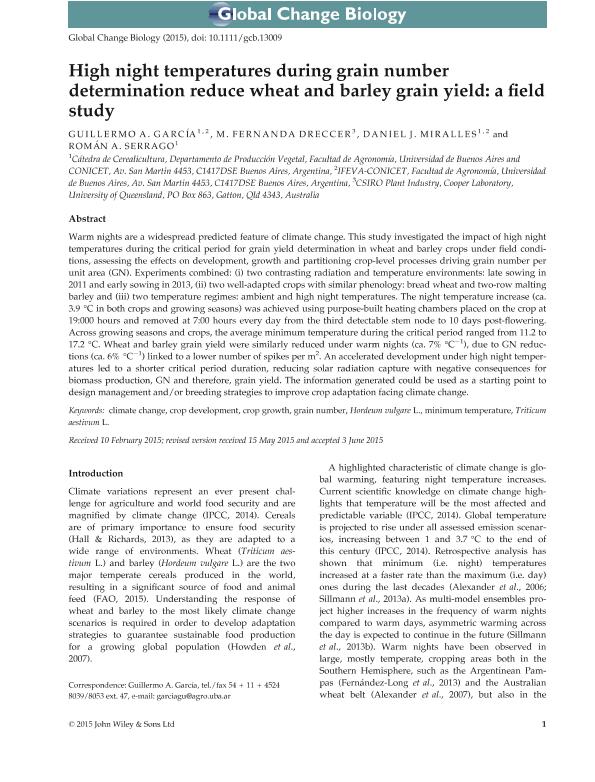Artículo
High night temperatures during grain number determination reduce wheat and barley grain yield: a field study
Fecha de publicación:
04/2015
Editorial:
Wiley
Revista:
Global Change Biology
ISSN:
1354-1013
Idioma:
Inglés
Tipo de recurso:
Artículo publicado
Clasificación temática:
Resumen
Warm nights are a widespread predicted feature of climate change. This study investigated the impact of high nighttemperatures during the critical period for grain yield determination in wheat and barley crops under field conditions,assessing the effects on development, growth and partitioning crop-level processes driving grain number perunit area (GN). Experiments combined: (i) two contrasting radiation and temperature environments: late sowing in2011 and early sowing in 2013, (ii) two well-adapted crops with similar phenology: bread wheat and two-row maltingbarley and (iii) two temperature regimes: ambient and high night temperatures. The night temperature increase (ca.3.9 °C in both crops and growing seasons) was achieved using purpose-built heating chambers placed on the crop at19:000 hours and removed at 7:00 hours every day from the third detectable stem node to 10 days post-flowering.Across growing seasons and crops, the average minimum temperature during the critical period ranged from 11.2 to17.2 °C. Wheat and barley grain yield were similarly reduced under warm nights (ca. 7% °C1), due to GN reductions(ca. 6% °C1) linked to a lower number of spikes per m2. An accelerated development under high night temperaturesled to a shorter critical period duration, reducing solar radiation capture with negative consequences forbiomass production, GN and therefore, grain yield. The information generated could be used as a starting point todesign management and/or breeding strategies to improve crop adaptation facing climate change.
Palabras clave:
Wheat
,
Barley
,
Temperatire
Archivos asociados
Licencia
Identificadores
Colecciones
Articulos(IFEVA)
Articulos de INST.D/INV.FISIOLOGICAS Y ECO.VINCULADAS A L/AGRIC
Articulos de INST.D/INV.FISIOLOGICAS Y ECO.VINCULADAS A L/AGRIC
Articulos(OCA PQUE. CENTENARIO)
Articulos de OFICINA DE COORDINACION ADMINISTRATIVA PQUE. CENTENARIO
Articulos de OFICINA DE COORDINACION ADMINISTRATIVA PQUE. CENTENARIO
Citación
García, Guillermo Ariel; Dreccer, M. Fernanda; Miralles, Daniel Julio; Serrago, Roman Augusto; High night temperatures during grain number determination reduce wheat and barley grain yield: a field study; Wiley; Global Change Biology; 21; 11; 4-2015; 4153–4164
Compartir
Altmétricas




